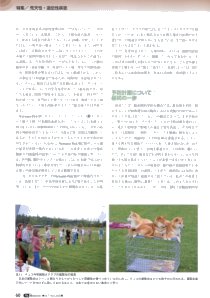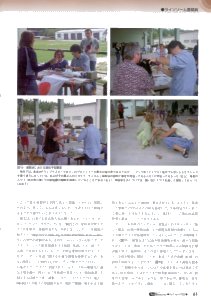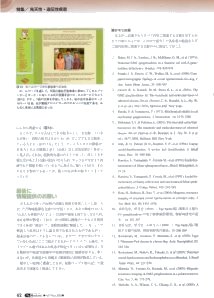|
Osamu Yamato's report on his visit to the Czech Shiba Club
|
|
For years Prof. Osamu Yamato has been researching inherited metabolic diseases in dogs and cats at the Hokkaido University in Sapporo. In December 2005 he published a longer article on this subject in Small Animal Medicine, the Japanese professional journal for veterinarians. In this article Prof. Yamato also reports on his visit to the Czech Shiba Club's general meeting in the late summer of 2005 in Zbraslav near Brno. At this meeting he took salivary samples from all Shibas present for a DNA analysis to ascertain if Czech Shibas possibly have the defect gene causing GM1 gangliosidosis. The result was negative; the report is published as follows: Osamu Yamato, Holger Funk, Natsuko Kawahara, et al., Mutation Screening of Canine GM1 Gangliosidosis for Preventive Measures: Absence of the Mutant Allele in Breeding Shiba Dogs in the Czech Republic. The Japanese Journal of Prophylatic Veterinary Medicine Vol. 1 (2009), 63-68.
The following is a translation of those pages in the article regarding Prof. Yamato's visit to the Shiba Club. The translation from Japanese was made by the courtesy of Takeshi Obata; it was reviewed by Osamu Yamato.
|
Osamu Yamato: Lysosomal storage diseases, Small Animal Medicine 40, vol. 7 no. 6 (2005), pp. 49-63 (here pp. 60-62)
Developing a prevention plan: a first step
As mentioned above, I believe that from a clinico-veterinary standpoint it should be an ultimate imperative to prevent the spread of hereditary diseases and by doing so to subdue them. From this point of view, I would like to introduce a first step towards a prevention plan against GM1 gangliosidosis in Shiba dogs. In theory, a prevention plan would mean using tests to determine the genotype of breeding dogs and then successively excluding carriers from breeding. However, for several reasons – I cannot specify all, but you can imagine easily what I mean – such a plan is very difficult to realise. But there will be no progress at all if we do not start at least with small steps and therefore it is important to develop a plan. I think that any kind of insight reached in this way will convince registered breeders from other countries and also the large number of breeders in Japan of the necessity of such a plan and so finally we will come closer to reaching our target. When I was confronted incidentally with this disease, I did not even think of eradicating it, but after realising that prevention and elimination are the most effective means in veterinary medicine – actually only few people share this opinion – I decided to do my best at all times to eradicate this disease.
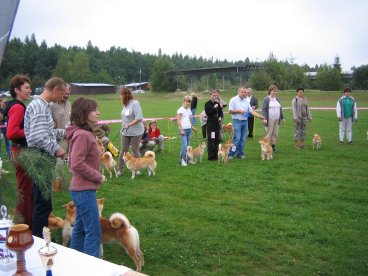 |
 |
Fig. 11: Scenes during the Czech Shiba Club show
In Japan, dog shows tend to be quiet and tense affairs while shows in the Czech Republic have a very relaxed atmosphere. I think dogs without leashes are hard to find in Japanese shows.
|
Shibas have always been very popular dogs in Japan and are also frequently exported to America, Europe, Asia and Australia. There is a big number of Shiba fanciers and Shiba clubs all over the world. This year there was a proposal for cooperation from the Shiba Club of the Czech Republic which offers information on GM1 gangliosidosis in three languages (English, German and Czech) on its website. In this way, many owners and breeders are provided with accurate information regarding this disease. Close cooperation developed with the members of the Czech Shiba Club who are very open-minded, and I had the opportunity to examine the genotypes of dogs that are registered in this club. The target was to exterminate the abnormal allele which is the cause of this disease. Since the introduction of the Shiba to the Czech Republic in 1989, more than 900 Shibas have been registered in the studbook, about 100 of them currently being used in breeding. It was planned to analyse the DNA of breeding dogs and to store them, thus making it possible to consult these samples for control purposes in the event of new hereditary diseases being detected.
 |
 |
Fig. 12: Investigation of the genotype before the show
My supporters: Holger Funk, webmaster of the Shiba Club's homepage. He contributed most to this project (German; wearing the T-shirt which I presented to him) and his wife Michaela (Czech; she co-ordinated the procedure for taking the buccal samples and wrote down the data).
On the other pictures you can see how the samples were taken from the dogs with a special swab. In cases where the dogs were nervous, I asked the owners to take the samples themselves.
|
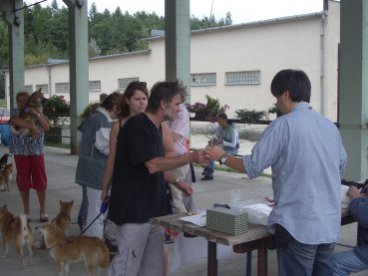 |
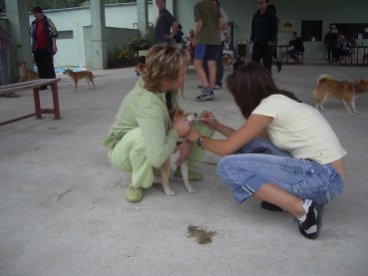 |
In autumn 2005, the Czech Shiba Club conducted a 2-day general meeting accompanied by a Club show. The meeting took place on an area used by several dog clubs. It is located near Brno, the second largest city in the country. (Fig. 11) In the run-up to this meeting, some problems occurred, but thanks to intensive information on the part of the club management, finally all members attending the meeting agreed to an examination. By using swabs buccal samples from a total number of 81 dogs were taken. (Fig. 12) I had already some experience in field research but this was the first time that I could reach such a large participation. After I returned no abnormalities could be detected in the analysis, but I expect more samples and results in the near future. It is just a small first step but I am sure that it was a step in the right direction. My sincere thanks go to the people of the club who co-operated with me. (Fig. 13)
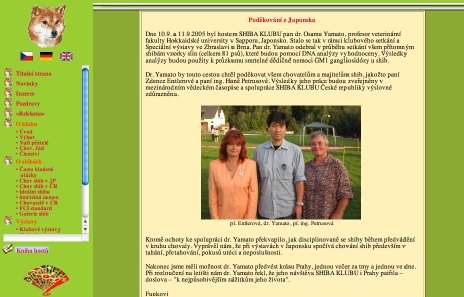 |
Fig. 13: Thanks to the participants via the Internet
I have expressed my sincere thanks to all breeders and owners participating in the genotype investigation in the Shiba Club's homepage. Holger and Michaela (Fig. 12) have translated this acknowledgement into Czech. You can see Zdenka Entlerová (left), the chairwoman of the Shiba Club, and Hana Petrusová (right), the breeding adviser.
I do appreciate the cooperation.
|
By the way, I had the impression that the Czech people love dogs and that there are many dog owners in this country. At least I have seen many people with dogs. Moreover, I believe that the Czech's relationship to their dogs is somewhat different to that in our country – to be honest, it is completely different. Obviously this is a question of culture. Probably the appreciation of dogs as such is not different, but the Czech people have a much more affectionate relation to their dogs. Even though I find it somewhat irritating and unexpected, I think that the Czech people have a better relation to the Shiba than the Japanese.
© Osamu Yamato & Holger Funk 2006

